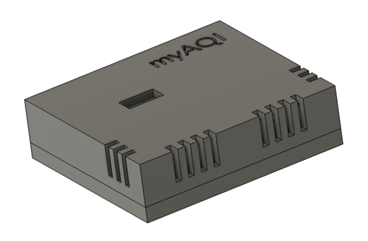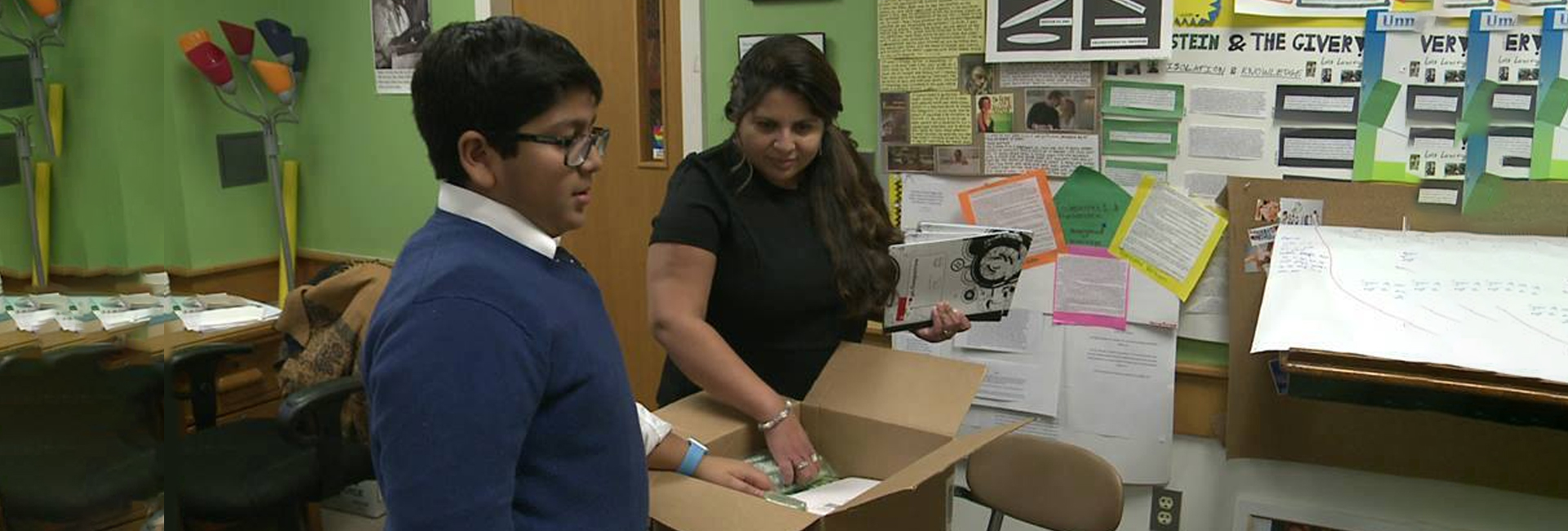(February 17, 2024) It was in December of 2019 that while navigating through the bustling streets of Delhi, New Jersey-based Rohan Varinakaval had to hold his breath to avoid a cloud of smog. His tryst with Delhi’s smog during his visit to India to meet his sick grandfather in a hospital left him shocked. It was a paradox – he could see that the capital was home to the best healthcare but at the time it was imprisoned by pollution, a result of farmers burning crop residue which was leading to an environmental health crisis. He found that this pollution is lessening the lifespan of an average Delhiite by nearly a decade. “Amidst this haze, thousands of students persistently attended school, their commitment to education unwavering. Students, even those with conditions such as asthma, were subjecting themselves to these toxic surroundings,” said Rohan, who saw a void in the realm of air quality monitoring.
This led him to take action, and he developed myAQI. Unlike regular monitors that only give air quality readings, myAQI does more. It gives schools easy advice based on current data. Instead of just knowing pollution levels, principals can get helpful tips like ‘Keep students inside during recess’ or ‘Open windows.’

Rohan Varinakaval
It began when Rohan realised that smog permeates through classrooms and even makes indoor learning environments safe, and the absence of air conditioning and filtration systems, it accelerates the risk. “Discussions with friends and family indicated that despite this grim scenario, the severe pollution was not being accorded priority, and school administrators were unable to address the health risks involved,” he added.
On delving deeper, he found that air quality monitoring devices only provide data but do not interpret air quality data. Moreover, their usage in Indian schools was almost negligible. “They received current air quality figures, but no practical steps to counter the problem,” revealed Rohan.
Passionate about engineering solutions, he was keen to find a solution. He spent countless hours talking to school leaders in both the US and India, making the app fit their needs, and fixing problems that popped up during testing the first version. So, using a particulate matter sensor and microprocessor, he created myAQI – a small, affordable air quality monitoring device designed especially for Indian schools. But what makes it different is its adaptability as Rohan understood that pollution affects people differently. Those who already have health problems like asthma, allergies, bronchitis, and COPD are more likely to get sick from bad air. His device helps provide customised recommendations for these sensitive groups, thus ensuring that everyone in the school, even those with health problems, stay safe.
“School administrators can install a myAQI device within their premises, register via an Android app, and obtain summaries of the air quality data. The most significant feature of the app, though, is its ability to offer recommendations for appropriate action based on the prevailing air quality and trends. It also allows administrators to view separate sets of suggestions tailored for different student populations with specific respiratory conditions such as asthma, allergies, bronchitis, and COPD,” he added.
The Indian-American teen wants school leaders to use myAQI to help shape school rules, make smarter choices about dealing with air quality, and understand pollution levels inside their buildings better. His device can sit in a classroom and gather data from a small area, so leaders can put it where it’s most needed.
Till now, the student at the Pingry School in New Jersey has distributed the device to ten schools in India, which include a total of over 16,000 students and is flooded with requests from many more schools. In the future, he wants to expand his project by providing several devices to each school. Additionally, he aims to inspire more young innovators to address environmental challenges globally.


myAQI
It was in December of 2019 that while navigating through the bustling streets of Delhi, New Jersey-based Rohan Varinakaval had to hold his breath to avoid a cloud of smog. His tryst with Delhi’s smog during his visit to India to meet his sick grandfather in a hospital left him shocked. It was a paradox – he could see that the capital was home to the best healthcare but at the time it was imprisoned by pollution, a result of farmers burning crop residue which was leading to an environmental health crisis. He found that this pollution is lessening the lifespan of an average Delhiite by nearly a decade. “Amidst this haze, thousands of students persistently attended school, their commitment to education unwavering. Students, even those with conditions such as asthma, were subjecting themselves to these toxic surroundings,” said Rohan, who saw a void in the realm of air quality monitoring.
This led him to take action, and he developed myAQI. Unlike regular monitors that only give air quality readings, myAQI does more. It gives schools easy advice based on current data. Instead of just knowing pollution levels, principals can get helpful tips like ‘Keep students inside during recess’ or ‘Open windows.’
It began when Rohan realised that smog permeates through classrooms and even makes indoor learning environments safe, and the absence of air conditioning and filtration systems, it accelerates the risk. “Discussions with friends and family indicated that despite this grim scenario, the severe pollution was not being accorded priority, and school administrators were unable to address the health risks involved,” he added.
On delving deeper, he found that air quality monitoring devices only provide data but do not interpret air quality data. Moreover, their usage in Indian schools was almost negligible. “They received current air quality figures, but no practical steps to counter the problem,” revealed Rohan.
Passionate about engineering solutions, he was keen to find a solution. He spent countless hours talking to school leaders in both the US and India, making the app fit their needs, and fixing problems that popped up during testing the first version. So, using a particulate matter sensor and microprocessor, he created myAQI – a small, affordable air quality monitoring device designed especially for Indian schools. But what makes it different is its adaptability as Rohan understood that pollution affects people differently. Those who already have health problems like asthma, allergies, bronchitis, and COPD are more likely to get sick from bad air. His device helps provide customised recommendations for these sensitive groups, thus ensuring that everyone in the school, even those with health problems, stay safe.
“School administrators can install a myAQI device within their premises, register via an Android app, and obtain summaries of the air quality data. The most significant feature of the app, though, is its ability to offer recommendations for appropriate action based on the prevailing air quality and trends. It also allows administrators to view separate sets of suggestions tailored for different student populations with specific respiratory conditions such as asthma, allergies, bronchitis, and COPD,” he added.
The Indian-American teen wants school leaders to use myAQI to help shape school rules, make smarter choices about dealing with air quality, and understand pollution levels inside their buildings better. His device can sit in a classroom and gather data from a small area, so leaders can put it where it’s most needed.
Till now, the student at the Pingry School in New Jersey has distributed the device to ten schools in India, which include a total of over 16,000 students and is flooded with requests from many more schools. In the future, he wants to expand his project by providing several devices to each school. Additionally, he aims to inspire more young innovators to address environmental challenges globally.
- Follow Rohan Varinakaval on LinkedIn




